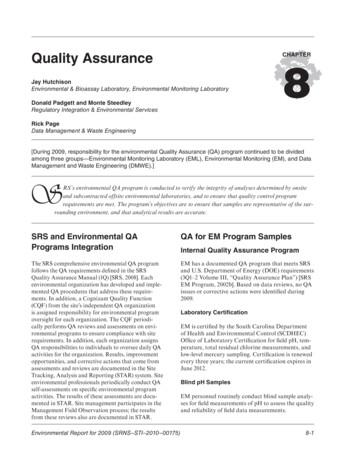Four State / EPA Region 7 State Implementation Plan (SIP .
Four State / EPA Region 7State Implementation Plan (SIP)Kaizen Process1
Why Do Kaizen Process for SIPs“Transform the SIP process into a moredynamic and collaborative, performanceoriented, multipollutant air qualitymanagement plan.”Air Quality Management in the United StatesNational Research Council2
Why Do Kaizen Process for SIPs? Duplicative Work Investment Time vs Environmental Results Past SIP Development and SIP ProcessingPerformance3
Goals of the Kaizen Event1.2.3.4.100% of approvable NAAQS SIPs occur within statutorytimeframes.SIPs of sufficient quality to be approvable on first pass.Reduce processing time by 50%.Eliminate 1/3 of SIP backlog each year for next 3 years.4
Kaizen Current Process5
Kaizen Future Process6
Old ProcessDesignationsPublic Process, Review,Final ApprovalSIP DevelopmentNew ProcessDesignationsSIP Development,Review Early guidance RPO involvement Concurrentmonitoring review Guidance onnational measures,menu, SIPtemplate Develop roadmap (includingworkshare) Early boundaryagreement withHQ/Region/State(unofficial) State share“complete” draftSIPs HQ/Regionsearly involvementPublic Process,Final Approval Final SIP100%approvable SupplementSIP template Publiccommentprocess7
Results of Kaizen EventCurrentSIP ProcessNewSIP ProcessPercentChange# of Steps165134 19%# of Decisions148 43%Best Case:Delay Time56 months(4.7 years)13 months(1.1 years) 77%Worst Case:Delay Time96 months(8 years)15 months(1.3 years) 84%Region 7: 340 days (0.9 years)EPA HQ: 1,080 days (3 years)State: 1,282 days (3.5 years)Total: 2,702 days (7.4 years)1,181 days(3.2 years) 56%Process Time8
TransferabilityKey elements: Simultaneous guidanceTimely ManagementDecisionsSIP TemplatesSIP RoadmapsEfficient public processRegion specific elements: Work sharingRPO utilizationCollaborative approachbetween states/regionWillingness by all partiesto work together on SIPsearly9
Questions?Rick Brunetti, DirectorBureau of AirKansas Department of Health and Environmentrbrunetti@kdheks.gov(785) 296-1593Josh Tapp, ChiefAir Planning BranchEPA Region 7Tapp.joshua@epa.gov(913) 551-760610
11
Workgroups: Tasks Going ForwardWorkgroupGoalsTimeframeSIP roadmap Develop template plan Hold roadmap meeting SIP template Create template Feedback Roll-out FederalRegister/publiccommentefficiencies Review/develop list of options toimprove efficiencies Review with state/select options Roll Out Plan Refine roll out plan, including actionitems, tracking system, schedule, etc. Refine presentation for key audience Schedule 30, 60, 90 day meetings 30days Assoon as possible90 days At promulgation ofNAAQS90 days 120 days At promulgation ofNAAQS90 days After promulgation ofNAAQS12
Workgroups: Tasks Going ForwardWorkgroupGoalsTimeframeFederal measures(rules & tools) Identify tools Explore rules Implement use of tools/rules Determine RPO capabilities,resources and tasks Finalize RPO involvement,get buy-in Initiate RPO activities At/after promulgation ofNAAQSReview existing controltechnologies Evaluate new and innovativetechnologies Provide menu of optionsto states 30 days 60 daysRPO tasksMenu of controloptions 90 daysAt/after promulgation ofNAAQS30 days 90 – 120 daysAt/after promulgation ofNAAQS13
Process ChangesActionIssue implementation rule and related guidance with NAAQSpromulgation (if complete guidance can’t be issued, identify key elementsthat states need to move forward and provide by memo)Initiate designation and SIP development process early in acollaborative processHQ RSXXDevelop designation and SIP roadmap for each area (identify workXXXXXshare opportunities)Joint session to agree on designation boundaryXXEarly nod of approval from EPA on designation boundaryXXStart SIP process early regardless of statutory timeframes (includeXlegal and enforcement review at state level)Utilize RPO for technical work for multi-state/multi-regionsX14
Process ChangesActionDevelop SIP template, menu of control options, quantify emissionreductions for national rules, evaluate rules that are regional/nationalin natureHQ RXXDevelop draft whole SIP package that includes all pieces of a SIP.Share with EPA early, prior to public meetings.XAddress all issues and comments at early draft stage so finaldocument ready to go at submittal.XXPublic comment strategy developed that includes options for efficientprocesses (e.g., direct final, parallel process)XXEliminate unnecessary documentation such as federal technicalsupport documents as part of FR package, completeness letter, etc.SXX15
Results of Kaizen Event Current SIP Process New SIP Process Percent Change # of Steps 165 134 19% # of Decisions 14 8 43% Best Case: Delay Time 56 months (4.7 years) 13 months (1.1 years) 77% Worst Case: Delay Time 96 months (8 years) 15 months (1.3 years) 84% Process Time Region 7: 340 days (0.9 years) 8 EPA HQ: 1,080 days (3 years)
Rapid Flow, Titration, Turbidimetry, Ultraviolet- Visible Spectroscopy (UV/VIS) Parameter/Analyte Water pH EPA 150.1 Turbidity EPA 180.1 Calcium EPA 200.7 Iron EPA 200.7 Magnesium EPA 200.7 Potassium EPA 200.7 Silica, Total EPA 200.7 Sodium EPA 200.7 Aluminum EPA 200.8 Antimony EPA 200.8 Arsenic EPA 200.8 .
EPA Test Method 1: EPA Test Method 2 EPA Test Method 3A. EPA Test Method 4 . Method 3A Oxygen & Carbon Dioxide . EPA Test Method 3A. Method 6C SO. 2. EPA Test Method 6C . Method 7E NOx . EPA Test Method 7E. Method 10 CO . EPA Test Method 10 . Method 25A Hydrocarbons (THC) EPA Test Method 25A. Method 30B Mercury (sorbent trap) EPA Test Method .
vii References The following resources were used in producing this manual: EPA: Package Treatment Plants MO-12, EPA 430/9-77-005, April 1977 EPA: Summary Report: The Causes and Control of Activated Sludge Bulking and Foaming, EPA 625/8-87/012, July 1987 EPA: Manual: Nitrogen Control, EPA 625/R-93/010, September 1993 EPA: Handbook: Retrofitting POTWs, EPA 625/6-89/020, July 1989
EPA Method 7E –NO, NO 2, NOx Yes EPA Method 8 –SO 2, SO 3 Yes EPA Method 10 –CO Yes EPA Method 11 –H 2 S ( 50 ppm Yes EPA Method 16 –TRS Yes, including mercaptans and other reduced sulphurs EPA Method 18 –VOC’s Yes EPA Method 26 –HCl, HF Yes EPA CTM 027 –NH 3 Yes. ADVANTAGES OF FTIR
40 CFR Part 63 [EPA-HQ-OAR-2019-0314, EPA-HQ-OAR-2019-0312, EPA-HQ-OAR-2019-0313, EPA-HQ-OAR-2017-0670, EPA-HQ-OAR-2017-0668, EPA-HQ-OAR-2017-0669; FRL-10006-70-OAR] RIN 2060-AT49 and RIN 2060-AT72 NESHAP: Surface Coating
the following methods: . (Standard Methods, 2540D), 27 metals by ICP-AES (EPA, 200.7), mercury by FIMS (EPA, 245.2),, and 18 metals by ICP-MS (EPA, 200.8) 42 volatile organic compounds by GC-MS (EPA, 8260B), 28 metals by ICP-AES (EPA, 6010C), mercury by FIMS (EPA, 7470A and 7471B), and 18 metals by ICP-MS (EPA, 6020A)
This quality assurance project plan (QAPP) is consistent with EPA Requirements for Quality Assurance Project Plans (EPA QA/R5, 2001, EPA/240/B-01/003); EPA Guidance for Quality Assurance Project Plans for Modeling (EPA QA/G-5M, 2002, EPA/240/R-02/007) and EPA
This EPA Brownfields Quality Assurance Project Plan (QAPP) Template is a generic format to be used for generating a QAPP for EPA Brownfields pilot projects in Region III. Prior to environmental data collection for a Brownfields pilot project, a site-specific Sampling and Analysis Plan must be submitted to EPA Region III for review and approval.























